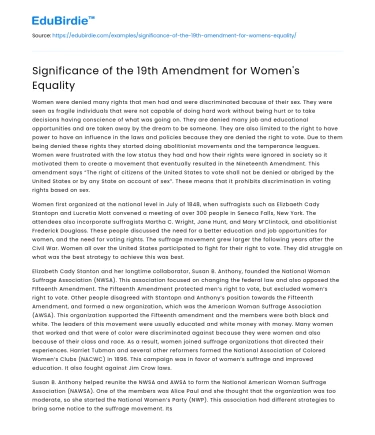Women were denied many rights that men had and were discriminated because of their sex. They were seen as fragile individuals that were not capable of doing hard work without being hurt or to take decisions having conscience of what was going on. They are denied many job and educational opportunities and are taken away by the dream to be someone. They are also limited to the right to have power to have an influence in the laws and policies because they are denied the right to vote. Due to them being denied these rights they started doing abolitionist movements and the temperance leagues. Women were frustrated with the low status they had and how their rights were ignored in society so it motivated them to create a movement that eventually resulted in the Nineteenth Amendment. This amendment says “The right of citizens of the United States to vote shall not be denied or abriged by the United States or by any State on account of sex”. These means that it prohibits discrimination in voting rights based on sex.
Women first organized at the national level in July of 1848, when suffragists such as Elizbaeth Cady Stantopn and Lucretia Mott convened a meeting of over 300 people in Seneca Falls, New York. The attendees also incorporate suffragists Martha C. Wright, Jane Hunt, and Mary M’Clintock, and abolitionist Frederick Douglass. These people discussed the need for a better education and job opportunities for women, and the need for voting rights. The suffrage movement grew larger the following years after the Civil War. Women all over the United States participated to fight for their right to vote. They did struggle on what was the best strategy to achieve this was best.
Save your time!
We can take care of your essay
- Proper editing and formatting
- Free revision, title page, and bibliography
- Flexible prices and money-back guarantee
Elizabeth Cady Stanton and her longtime collaborator, Susan B. Anthony, founded the National Woman Suffrage Association (NWSA). This association focused on changing the federal law and also opposed the FIfteenth Amendment. The Fifteenth Amendment protected men’s right to vote, but excluded women’s right to vote. Other people disagreed with Stantopn and Anthony’s position towards the Fifteenth Amendment, and formed a new organization, which was the American Woman Suffrage Association (AWSA). This organization supported the Fifteenth amendment and the members were both black and white. The leaders of this movement were usually educated and white money with money. Many women that worked and that were of color were discriminated against because they were women and also because of their class and race. As a result, women joined suffrage organizations that directed their experiences. Harriet Tubman and several other reformers formed the National Association of Colored Women’s Clubs (NACWC) in 1896. This campaign was in favor of women’s suffrage and improved education. It also fought against Jim Crow laws.
Susan B. Anthony helped reunite the NWSA and AWSA to form the National American Woman Suffrage Association (NAWSA). One of the members was Alice Paul and she thought that the organization was too moderate, so she started the National Women’s Party (NWP). This association had different strategies to bring some notice to the suffrage movement. Its members did demonstrations in nearby Lafayette Park in the U.S. Capitol and Senate office buildings. They participated to importune nonviolent protests, hunger strikes, civil disobedience, and silent vigils. Some of the more noticeable actions were street speaking, pageants, and parades. Alice Paul organized the largest suffrage pageant, which took place in Washington, D.C. on March 3, 1913. Around eight thousand women marched from the Capitol to the White House, carrying banners and escorting floats. There were about 500 thousand people watching the march and only some of them supported it. Some of the suffragists were harassed and attacked in this parade. Many women had to be hospitalized because of the injuries that were left. This was an important parade because it was a big parade and the women were rebelling against the way people see women as being obligated to act. They were loud and let out what they wanted and they were secure of what they were doing and that it was going to work. The people who opposed women’s suffrage feared that society would change in such a way that it would suffer if women played roles besides being wive’s and mothers. The opposition at some time will be eventually overruled.
The House of Representatives and the Senate passed the Nineteenth Amendment in 1919. Then it went through the states ratification. Thirty-six states needed to ratify the amendment in order for it to be adopted. Hary Burn in the Tennessee House of Representatives had to cast the final vote. Burn’s first decision was to vote against the amendment, but he changed his mind when his mother told him to “be a good boy” and vote for ratification. The Nineteenth Amendment went into effect on August 18, 1920. On November 2 of the same year, more than eight million women voted in the U.S. election for the first time. Many women started to run for political office. The first woman to hold an office before the ratification was Jeanette Rankin and when she was elected in Congress she said “I may be the first woman member of congress. But I won’t be the last''.
The 19th Amendment helped millions of women move closer to equality in all aspects of American life. Women advocated for job opportunities, fairer wages, education, sex education, and birth control.






 Stuck on your essay?
Stuck on your essay?

